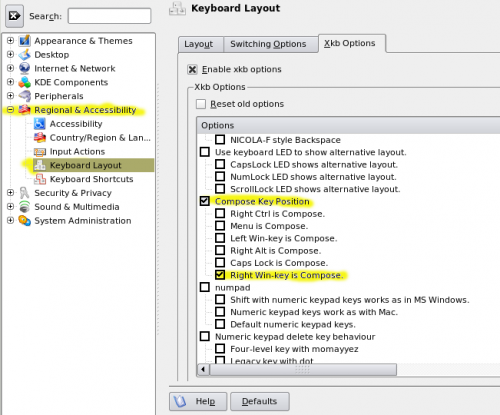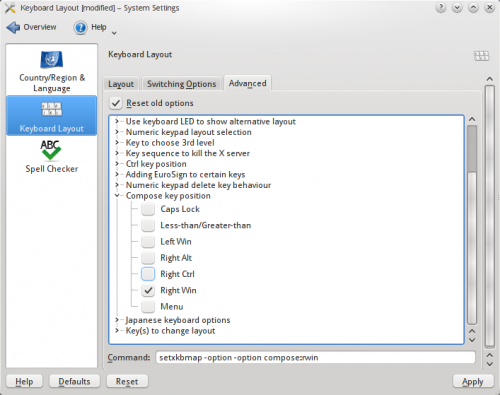Tutorials/ComposeKey/de: Difference between revisions
No edit summary |
Updating to match new version of source page |
||
| Line 1: | Line 1: | ||
<languages /> | <languages /> | ||
<span class="mw-translate-fuzzy"> | |||
=== Einleitung === | === Einleitung === | ||
</span> | |||
Die '''Compose-Taste''' wird verwendet um Zeichen auf der Tastatur zu tippen, die normalerweise nicht verfügbar sind. Solche Zeichen können "Umlaute", ein "Längezeichen" oder Akzente auf Buchstaben werden: | Die '''Compose-Taste''' wird verwendet um Zeichen auf der Tastatur zu tippen, die normalerweise nicht verfügbar sind. Solche Zeichen können "Umlaute", ein "Längezeichen" oder Akzente auf Buchstaben werden: | ||
| Line 14: | Line 15: | ||
Die folgenden Anweisungen werden eine ''Compose''-Taste einrichten, die auf die ''rechte Logo-Taste'' gelegt wird (auf den meisten Tastaturen ist dieses Logo das ''Windows''logo). | Die folgenden Anweisungen werden eine ''Compose''-Taste einrichten, die auf die ''rechte Logo-Taste'' gelegt wird (auf den meisten Tastaturen ist dieses Logo das ''Windows''logo). | ||
<span class="mw-translate-fuzzy"> | |||
=== Konfiguration über das Terminal === | === Konfiguration über das Terminal === | ||
</span> | |||
Um dies richtig zu tun, werde ich versuchen den "ganzheitlichen" Weg über das Terminal zu gehen: | Um dies richtig zu tun, werde ich versuchen den "ganzheitlichen" Weg über das Terminal zu gehen: | ||
| Line 30: | Line 33: | ||
** Eine neue ''Initial RAM-Disk'' für den nächsten Start wird nun erstellt. | ** Eine neue ''Initial RAM-Disk'' für den nächsten Start wird nun erstellt. | ||
<span class="mw-translate-fuzzy"> | |||
=== KDE 3.x Konfiguration === | === KDE 3.x Konfiguration === | ||
</span> | |||
Now we can go on and configure our windowing environment. This description uses either ''Kcontrol'' or the Kubuntu configuration tool, which exposes the same option dialogue. | Now we can go on and configure our windowing environment. This description uses either ''Kcontrol'' or the Kubuntu configuration tool, which exposes the same option dialogue. | ||
| Line 43: | Line 48: | ||
== KDE SC 4.0-4.4 configuration == | |||
Now we can go on and configure our windowing environment (Plasma). This description uses the '''System Settings''' as they're available in the K-Menu of the Kubuntu install: | Now we can go on and configure our windowing environment (Plasma). This description uses the '''System Settings''' as they're available in the K-Menu of the Kubuntu install: | ||
| Line 54: | Line 59: | ||
[[Image:ControlKeyKDE4.png|500px|center]] | [[Image:ControlKeyKDE4.png|500px|center]] | ||
== | == Current KDE Configuration == | ||
These instructions apply | These instructions apply to KDE 4.5 and above. | ||
* Start '''System Settings''' | * Start '''System Settings''' | ||
* <menuchoice>Input Devices</menuchoice> | * <menuchoice>Input Devices</menuchoice> | ||
| Line 63: | Line 68: | ||
* Choose the key you prefer | * Choose the key you prefer | ||
== Configuration for GTK Applications (Gnome, Firefox, etc.) == | |||
GTK (such as also Firefox) and Gnome applications use (on an Ubuntu system) usually ''SCIM'' as the input method, not ''XIM'' (X Input Method) that relies on the configurations from (X)Compose. Therefore, you will often find that the "a" and "o" macron characters can yield the female/male ordinals "ª" and "º". To still make it work, GTK applications need to be "told" to use XIM instead. | |||
=== "One Off" Configuration === | |||
For a single application you can do it by just setting the environment variable ''GTK_IM_MODULE'' for the application to be launched to '''xim''': | For a single application you can do it by just setting the environment variable ''GTK_IM_MODULE'' for the application to be launched to '''xim''': | ||
| Line 79: | Line 84: | ||
This can, of course, also be persisted for a single user in your ''~/.bash_profile'', or for all users in ''/etc/environment''. This is, however, the less elegant way, the more elegant way follows below. | This can, of course, also be persisted for a single user in your ''~/.bash_profile'', or for all users in ''/etc/environment''. This is, however, the less elegant way, the more elegant way follows below. | ||
=== Persistent Configuration === | |||
* Copy the setup file ''/etc/X11/xinit/xinput.d/default'' to ''/etc/X11/xinit/xinput.d/xim'' | * Copy the setup file ''/etc/X11/xinit/xinput.d/default'' to ''/etc/X11/xinit/xinput.d/xim'' | ||
| Line 103: | Line 108: | ||
* After a restart of the X server everything should work. | * After a restart of the X server everything should work. | ||
=== Optional Tweaking of XCompose Map === | |||
Now that you're using XIM, you can further tweak the XCompose input map for further characters, or for characters in more convenient locations, etc. | Now that you're using XIM, you can further tweak the XCompose input map for further characters, or for characters in more convenient locations, etc. | ||
| Line 124: | Line 129: | ||
* Just log out and in again (no restart necessary), and you can use your new "multi key short strokes" using the compose key to your desire. As you see this even works for creating longer character sequences. | * Just log out and in again (no restart necessary), and you can use your new "multi key short strokes" using the compose key to your desire. As you see this even works for creating longer character sequences. | ||
== Typing Macrons, Umlauts, Accents, ... == | |||
The <keycap>compose</keycap> key will be now whatever you have configured it to be, e. g. <keycap>right logo</keycap>. | The <keycap>compose</keycap> key will be now whatever you have configured it to be, e. g. <keycap>right logo</keycap>. | ||
| Line 148: | Line 153: | ||
* More bindings can be found in ''/usr/share/X11/locale/en_US.UTF-8/Compose'' | * More bindings can be found in ''/usr/share/X11/locale/en_US.UTF-8/Compose'' | ||
<span id="Links and Further Information"></span> | <span id="Links and Further Information"></span> | ||
== Links and Further Information == | |||
* http://cyberborean.wordpress.com/2008/01/06/compose-key-magic/ | * http://cyberborean.wordpress.com/2008/01/06/compose-key-magic/ | ||
Revision as of 18:21, 20 July 2011
Einleitung
Die Compose-Taste wird verwendet um Zeichen auf der Tastatur zu tippen, die normalerweise nicht verfügbar sind. Solche Zeichen können "Umlaute", ein "Längezeichen" oder Akzente auf Buchstaben werden:
Diese Beschreibungen wurden auf einigen Kubuntu Hardy Heron 8.04.1 Systemen getestet. Weitere Informationen finden Sie in dem Abschnitt Verknüpfungen und weitere Informationen unterhalb.
Die Änderungen werden unter (fast) allen Anwendungen, einschließlich der Arbeitsflächenumgebung, Browser, OpenOffice.org, sowie viele Konsolen / Nur Text-Anwendungen, funktionieren.
Die folgenden Anweisungen werden eine Compose-Taste einrichten, die auf die rechte Logo-Taste gelegt wird (auf den meisten Tastaturen ist dieses Logo das Windowslogo).
Konfiguration über das Terminal
Um dies richtig zu tun, werde ich versuchen den "ganzheitlichen" Weg über das Terminal zu gehen:
- Rekonfigurieren der Konsole für die benutzte Tastatur und Zeichencodierung. Um dies durchzuführen geben Sie dies in ein Text-Terminal oder die Konsole ein.
$ sudo dpkg-reconfigure console-setup
- Befolgen Sie diese Schritte der Konfiguration:
- Wählen Sie Ihre Tastatur (hier eine Standard 104 US-Tastatur)
- Wenn Sie einen !AltGr-Tasten-Ersatz wünschen, wählen Sie ihn
∗ Wählen Sie die Taste, die Ihre Compose-Taste sein soll. Ich benutze die Symboltaste rechts.
Ich würde lieber die Symboltaste links nutzten, aber diese ist in den Konsoleneinstellungen nicht verfügbar. Aber in der grafischen Fenster-Umgebung (KDE Plasma) ist dies möglich.
- Wählen Sie als Konsolen-Kodierung UTF-8
- Wählen Sie welcher Zeichensatz auf der Konsole verfügbar sein soll. Ich nutze Kombiniert - Latein, slawisches Kyrillisch, Hebräisch, einfaches Arabisch.
Ich denke, dass die Auswahl mir die gewünschten Zeichen bietet.
- Wählen Sie welche Konsolenausgabe Sie wünschen (was immer Sie möchten, um sicher zu gehen kann man die gegebenen aktuellen Standardwerte nutzen)
- Eine neue Initial RAM-Disk für den nächsten Start wird nun erstellt.
KDE 3.x Konfiguration
Now we can go on and configure our windowing environment. This description uses either Kcontrol or the Kubuntu configuration tool, which exposes the same option dialogue.
- Start the System Settings or the KDE Control Center
- (for System Settings) or (for Control Centre) ->
- Choose your keyboard layout
- Modify the <menuchioce>Xkb Options</menuchioce> to select/enable the compose key

KDE SC 4.0-4.4 configuration
Now we can go on and configure our windowing environment (Plasma). This description uses the System Settings as they're available in the K-Menu of the Kubuntu install:
- Start the System Settings
- Select the configuration
- Under the Layout tab, select
- Modify Advanced options to select/enable the compose key

Current KDE Configuration
These instructions apply to KDE 4.5 and above.
- Start System Settings
- Keyboard tab at left (should be initially selected)
- tab at top right
- Expand .
- Choose the key you prefer
Configuration for GTK Applications (Gnome, Firefox, etc.)
GTK (such as also Firefox) and Gnome applications use (on an Ubuntu system) usually SCIM as the input method, not XIM (X Input Method) that relies on the configurations from (X)Compose. Therefore, you will often find that the "a" and "o" macron characters can yield the female/male ordinals "ª" and "º". To still make it work, GTK applications need to be "told" to use XIM instead.
"One Off" Configuration
For a single application you can do it by just setting the environment variable GTK_IM_MODULE for the application to be launched to xim:
$ GTK_IM_MODULE=xim firefox
More permanently that can be done for a single shell session like this:
$ export GTK_IM_MODULE=xim
This can, of course, also be persisted for a single user in your ~/.bash_profile, or for all users in /etc/environment. This is, however, the less elegant way, the more elegant way follows below.
Persistent Configuration
- Copy the setup file /etc/X11/xinit/xinput.d/default to /etc/X11/xinit/xinput.d/xim
$ sudo cp /etc/X11/xinit/xinput.d/default /etc/X11/xinit/xinput.d/xim
- Edit the file /etc/X11/xinit/xinput.d/xim and set the input method for GNOME and KDE to xim
...
GTK_IM_MODULE=xim
QT_IM_MODULE=xim
...
- Create a link for the locale all_ALL (or the desired locale only):
$ sudo ln -sf /etc/X11/xinit/xinput.d/xim /etc/X11/xinit/xinput.d/all_ALL
If you are using a Debian-derived distribution use following instead
$ sudo update-alternatives --verbose --install /etc/X11/xinit/xinput.d/all_ALL xinput-all_ALL /etc/X11/xinit/xinput.d/xim 20
- After a restart of the X server everything should work.
Optional Tweaking of XCompose Map
Now that you're using XIM, you can further tweak the XCompose input map for further characters, or for characters in more convenient locations, etc.
To do that follow these steps:
- Create a ~/.XCompose file, and put the following lines into it:
# ~/.XCompose
# This file defines custom Compose sequences for Unicode characters<br />
# Import default rules from the system Compose file:
include "/usr/share/X11/locale/en_US.UTF-8/Compose"<br />
# To put some stuff onto compose key strokes:
<Multi_key> <minus> <greater> : "→" U2192 # Compose - >
<Multi_key> <colon> <parenright> : "☺" U263A # Compose : )
<Multi_key> <h> <n> <k> : "hugs and kisses" # Compose h n k
<Multi_key> <less> < p> : "< p></p>" # Compose < p
- Just log out and in again (no restart necessary), and you can use your new "multi key short strokes" using the compose key to your desire. As you see this even works for creating longer character sequences.
Typing Macrons, Umlauts, Accents, ...
The compose key will be now whatever you have configured it to be, e. g. right logo.
- Macrons
'"`UNIQ--keycap-0000001C-QINU`"' then ''<vowel >''
or
'"`UNIQ--keycap-0000001F-QINU`"' then ''<vowel >''
-->
āēīōū ĀĒĪŌŪ
- Umlauts
'"`UNIQ--keycap-00000022-QINU`"' then ''<vowel >''
or
'"`UNIQ--keycap-00000025-QINU`"' then ''<vowel >''
-->
äëïöü ÄËÏÖÜ
- The German Ess-Zet ligature
'"`UNIQ--keycap-00000028-QINU`"' then '"`UNIQ--keycap-00000029-QINU`"' and '"`UNIQ--keycap-0000002A-QINU`"' (twice the "s")
-->
ß
- More bindings can be found in /usr/share/X11/locale/en_US.UTF-8/Compose
Links and Further Information
- http://cyberborean.wordpress.com/2008/01/06/compose-key-magic/
- http://ubuntuforums.org/showthread.php?t=209115
- http://www.seedwiki.com/wiki/takomapark/compose2
- http://wiki.linuxquestions.org/wiki/Accented_Characters
- http://people.uleth.ca/~daniel.odonnell/Blog/custom-keyboard-in-linuxx11
- http://hdante.blogspot.com/2007/05/kiel-oni-skribas-typing-esperanto.html
